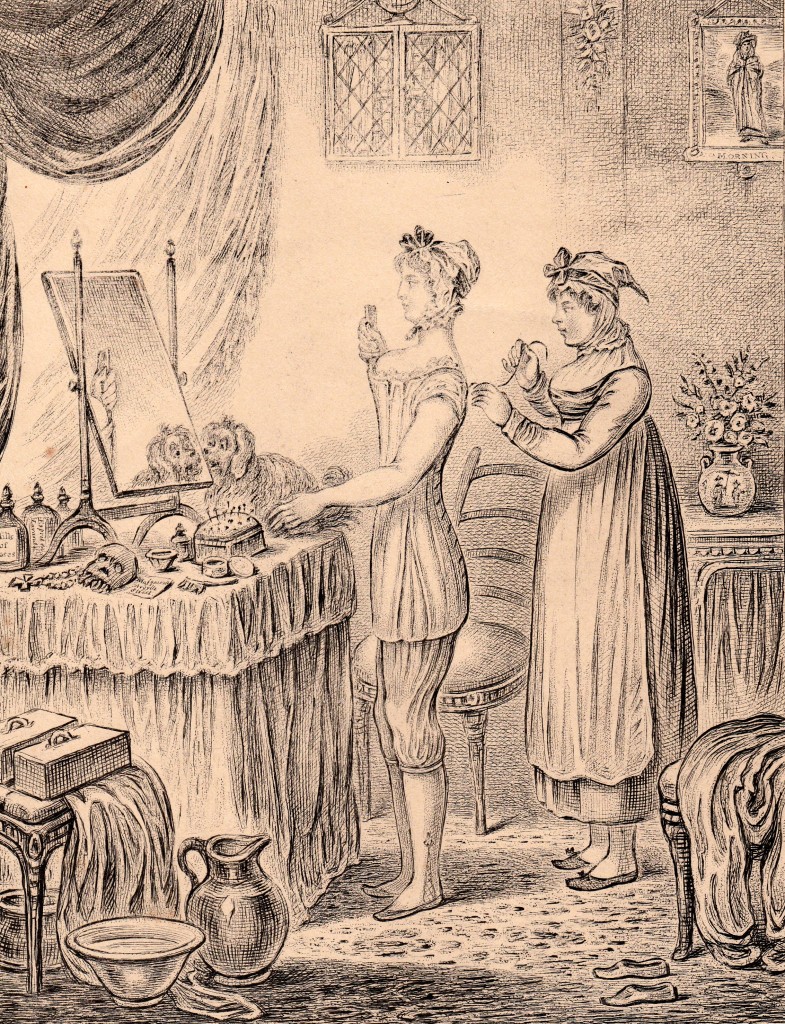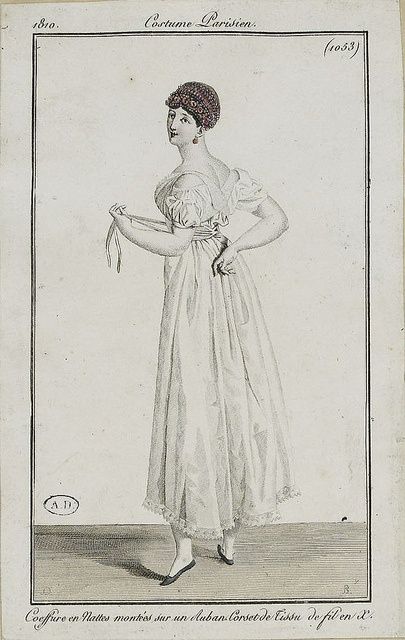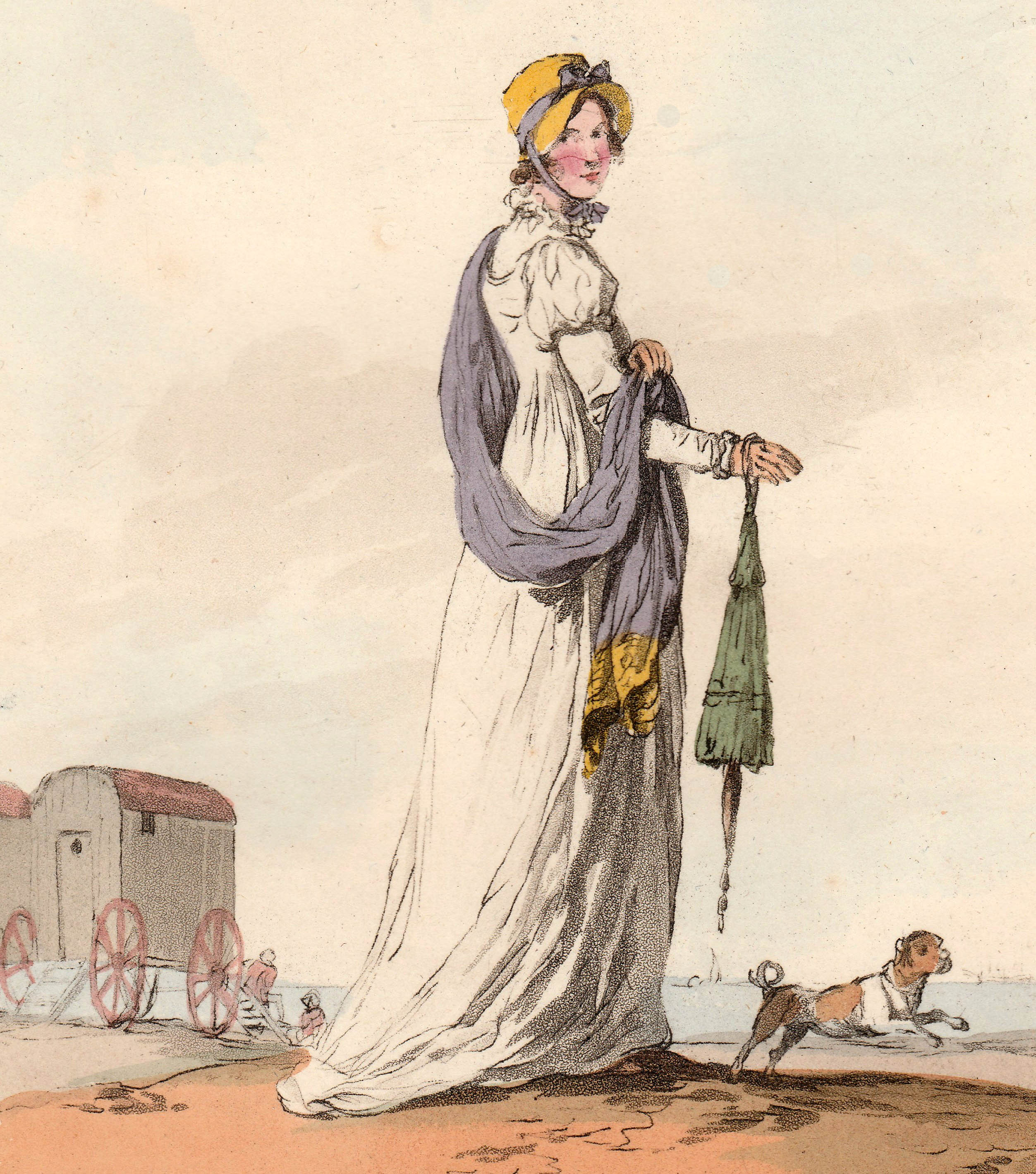I was puzzling the other day over whether it would be more correct for my heroine to be wearing a corset or stays – or what exactly jumps were – so I did a little research.

To begin with Stays: the Oxford English Dictionary has “Stays (also a pair of stays). A laced under-bodice, stiffened by the insertion of strips of whalebone (sometimes of metal or wood) worn by women (sometimes by men) to give shape and support to the figure: = CORSET.”
The word is used in the sense of ‘staying’ something – securing it or holding it firm.
The earliest use given is 1608 and the use of the plural “is due to the fact that stays were originally (as they still are usually) made in two pieces laced together.” Presumably in the same way that we speak of a pair of drawers, which used to consist of two separate legs tied at the waist.
As for the Corset, the OED goes back to 1299 for the first use of the word, although that was a medieval outer garment. The earliest example they give for it as an undergarment is in The Times for 1795 – “Corsettes about six inches long [presumably this means the depth top to bottom], and a slight buffon tucker of two inches high, are now the only defensive paraphernalia of our fashionable Belles.” From the spelling and the timing it would appear that this term comes via the French and relates to the light, often uncorsetted, Empire fashions of the Revolution. They also quote a patent application of 1796 for “An improvement in the making of stays and corsettes.”
And finally Jumps. A jump was man’s short coat (17th & 18thc) also used generally, in the plural, for clothes, especially in country areas. But also a “kind of under (or undress) bodice worn by women, esp. during the 18th century, and in rural use in the 19th; usually fitted to the bust, and often used instead of stays. From c.1740 usually as plural jumps (a pair of jumps).” Oxford English Dictionary.
They seem to have been laced at the front, often had shoulder straps and were only lightly boned, if at all. This made them particularly suitable for women performing manual work and for nursing mothers.
A pair of jumps can be seen here c. 1770. The jumps are on the far left, with a corset hanging next to them.

For those British ladies not following extreme French fashion, the ‘long stay’ was the most used until about 1810. It is well illustrated in the satirical drawing at the top of the page: Gilray, Progress of the Toilet: The Stays published in February 1810. It laces right up the back (with one lace), covers the hips and is made to cup and support the bust. Unusually for this early date the lady is wearing knee-length drawers.
The fabric for long stays was jean (a strong twilled cotton) or buckram (a stiff cotton or linen soaked in a size such as wheat starch).
At this period, before the mass production of metal eyelets, the lace holes were simply strengthened with buttonhole stitch and would not take the strain of ferociously tight lacing. Shape therefore depended a great deal on the original cut of the garment and on its stout cloth and boning.
Many styles of stays were invented, experimenting with various fabrics for more flexibility, support and comfort and some stay-makers advertised more than fifteen varieties.
The extreme compression of the long stay gave rise to various health concerns, to say nothing of discomfort, and from about 1810 the short stay came into fashion, along with the ‘Divorce Corset’ designed to push the breasts apart.
Even with the short corset, there were critics. C. Willett Cunnington quotes one (unfortunately without attribution) as ranting in 1811: “…in eight women out of ten, the hips squeezed into a circumference little more than the waist; and the bosom shoved up to the chin, making a sort of fleshy shelf disgusting to the beholders and certainly most incommodious to the wearer.”
By September 1813 Jane Austen was writing to her sister Cassandra with the latest fashion news from London. “I learnt from Mrs Tickar’s young Lady [presumably her lady’s maid], to my high amusement, that the stays are now not made to force the Bosom up at all: that was a very unbecoming, unnatural fashion.”

The short stays were much more like a modern bra and did nothing to restrain the stomach or hips. A French pair from 1810 are shown above in a print designed to show how easy they were to put on.

This pair, for which I do not have a source, are laced up at the front.
The advertisements in La Belle Assemblee show how stays were promoted, with makers striving to differentiate their products.
In February 1809: “The much approved entire new Cotton and Brace Corset, invented and made only by Misses Linckmyers, No.12, Frith-street, Soho-square….entirely obviate every inconvenience frequently attending long stays…”
In April the same year these two adverts appeared:


Mrs Barclay is also operating in Frith Street, a short distance from the Misses Linckmyers. Not only are her corsets ‘fashionable’, but they are also ‘cheap’ and the increasing desire for comfort can be seen in the reference to ‘the simple vest’.
After all that my heroine is definitely opting for a short corset, if not a nice comfy pair of jumps!







 The image above is from La Belle Assemblée for October 1809 and shows ‘Sea Coast Promenade Fashion.’
The image above is from La Belle Assemblée for October 1809 and shows ‘Sea Coast Promenade Fashion.’ Somewhat later – I do not have a date for this, but it is c1820 – is this ‘Walking Dress’ from Ackermann’s Repository. I can’t help feeling that this lady is looking positively shifty as she readies her telescope.
Somewhat later – I do not have a date for this, but it is c1820 – is this ‘Walking Dress’ from Ackermann’s Repository. I can’t help feeling that this lady is looking positively shifty as she readies her telescope.




 What did one wear to get to and from those bathing machines? The ever-inventive Mrs Bell produced a magnificent ‘Sea Side Bathing Dress’ for the August 1815 edition of La Belle Assemblée. This is not the costume for entering the sea but for wearing to get there, and it is lavishly trimmed in drooping green, presumably to imitate seaweed. Note the bag she is carrying. This contains Mrs Bell’s ‘Bathing Preserver’ which she produced in 1814. You can see it in its bag again below (La Belle Assemblée September 1814). Here the lady is wearing ‘Sea Side Morning Dress’ with ‘Bathing Preserver. Invented & to be had exclusively of Mrs Bell, No.26 Charlotte Street, Bedford Square.’ The Preserver is in the bag lying beside her chair.
What did one wear to get to and from those bathing machines? The ever-inventive Mrs Bell produced a magnificent ‘Sea Side Bathing Dress’ for the August 1815 edition of La Belle Assemblée. This is not the costume for entering the sea but for wearing to get there, and it is lavishly trimmed in drooping green, presumably to imitate seaweed. Note the bag she is carrying. This contains Mrs Bell’s ‘Bathing Preserver’ which she produced in 1814. You can see it in its bag again below (La Belle Assemblée September 1814). Here the lady is wearing ‘Sea Side Morning Dress’ with ‘Bathing Preserver. Invented & to be had exclusively of Mrs Bell, No.26 Charlotte Street, Bedford Square.’ The Preserver is in the bag lying beside her chair.














 An invention of 1816, and applied to persons whose extravagant dress called forth the sneers of the vulgar; they were mostly young men who had this designation, and they were charged with wearing stays – a mistake easily fallen into, their wide web-belts having that appearance. Men of fashion became dandy soon after; having imported a good deal of French manner in their gait, lispings, wrinkled foreheads, killing king’s English, wearing immense pleated pantaloons, the coat cut away, small waistcoat, with cravat and chitterlings* immense: Hat small; hair frizzled and protruding. If one fell down he could not rise without assistance. Yet they assumed to be a little au militaire, and some wore mustachios. Lord Petersham was at the head of this sect of mannerists.
An invention of 1816, and applied to persons whose extravagant dress called forth the sneers of the vulgar; they were mostly young men who had this designation, and they were charged with wearing stays – a mistake easily fallen into, their wide web-belts having that appearance. Men of fashion became dandy soon after; having imported a good deal of French manner in their gait, lispings, wrinkled foreheads, killing king’s English, wearing immense pleated pantaloons, the coat cut away, small waistcoat, with cravat and chitterlings* immense: Hat small; hair frizzled and protruding. If one fell down he could not rise without assistance. Yet they assumed to be a little au militaire, and some wore mustachios. Lord Petersham was at the head of this sect of mannerists. Kid, Kiddy and Kidling implies youth; but an old evergreen chap may be dressed kiddily, i.e. knowingly, with his hat on one side, shirt-collar up on high, coat cut away in the skirts, or outside breast-pockets, a yellow, bird’s-eye-blue , or Belcher fogle*, circling his squeeze**, and a chitterling shirt*** of great magnitude protruding on the sight, and wagging as its wearer walks. These compounded compose the kiddy; and if father and son come it in the same style, the latter is a kidling.
Kid, Kiddy and Kidling implies youth; but an old evergreen chap may be dressed kiddily, i.e. knowingly, with his hat on one side, shirt-collar up on high, coat cut away in the skirts, or outside breast-pockets, a yellow, bird’s-eye-blue , or Belcher fogle*, circling his squeeze**, and a chitterling shirt*** of great magnitude protruding on the sight, and wagging as its wearer walks. These compounded compose the kiddy; and if father and son come it in the same style, the latter is a kidling.









